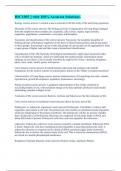BSC1005 || with 100% Accurate Solutions.
Biology correct answers A natural science concerned with the study of life and living organisms.
Hierarchy of life correct answers The biological levels of organization of living things arranged from the simplest to most complex are: organelle, cells, tissues, organs, organ systems, organisms, populations, communities, ecosystem, and biosphere.
Taxonomy and classification of life correct answers Taxonomy: the academic discipline of defining groups of biological organisms on the basis of shared characteristics and giving names to those groups. Each group is given a rank and groups of a given rank can be aggregated to form
a super group of higher rank and thus create a hierarchical classification.
Classification of life: The hierarchy of biological classification's eight major taxonomic ranks. Life is divided into domains, which are subdivided into further groups. Intermediate minor rankings are not shown. Life is usually classified by eight levels of taxa—domains, kingdoms, phyla, class, order, family, genus, and species.
Carl Linnaeus correct answers Swedish botanist, physician and zoologist who laid the foundations for the modern scheme of nomenclature; known as the "father of modern taxonomy"
Characteristics of living things correct answers characteristics of living things are order, stimuli, reproduction, growth/development, regulation, homeostasis, and energy.
Energy pyramid correct answers A graphical representation of the energy contained in succeeding trophic levels, with maximum energy at the base (primary producers) and steadily diminishing amounts at higher levels
3 domains of life correct answers Bacteria, Archaea and Eukarya are the three domains of life.
Cells correct answers A membrane bound structure that is the basic unit of life
Prokaryotic vs. eukaryotic organisms correct answers Prokaryotic: Unicellular (1 entity), lack organelles, and contain a cell wall. The prokaryotic cell contains no membrane-bound organelles which are independent of the plasma membrane. The prokaryotic cell has no nucleus. Smaller than a Eukaryotic Cell.Prokaryotic ribosomes are composed of only three kinds of rRNA and about fifty kinds of protein. Prokaryotic cells have only one organelle: the ribosomes.
eukaryotic: Eukaryotic cells have a true nucleus, bound by a double membrane. Eukaryotic DNA
is linear. Eukaryotic cells have membrane-bound organelles. Larger than prokaryotic cells. A eukaryotic ribosome is composed of five kinds of rRNA and about eighty kinds of proteins. Eukaryotic has a nucleus, the control center of the cell. This is where the chromosomes (DNA) are stored in a double phospholipid membranes.
Kingdoms of domain Eukarya correct answers Protista, Fungi, Anamalia, Plantae Trophic levels in food chains/food webs correct answers Organisms can be organized into trophic levels: primary producer, primary consumer, secondary consumer, and tertiary or higher-
order consumer.
Carbon cycle correct answers The biogeochemical cycle by which carbon moves from its reservoirs in the atmosphere and oceans through producers and into higher trophic levels, and then back to its resevoirs
Hydrologic cycle correct answers The biogeochemical cycle by which water travels from its major reservoir, the oceans, through the atmosphere to reservoirs in freshwater lakes, rivers, and groundwater, and back into the oceans. The hydrologic cycle is driven by solar energy. Nearly all
water remains as water throughout the cycle (rather than being used in the synthesis of new molecules)
Organism vs. Population vs. Community vs. Ecosystem correct answers Organism: a group of organisms that can reproduce and produce fertile offspring.
Population: a group of organisms of the same species living in an area at the same time.
Community: a group of populations living and interacting with each other in an area.
Ecosystem: the community and their abiotic environment.
Herbivores, Omnivores, Carnivores correct answers Herbivores: an animal that eats only plants
Omnivores: an animal that eats both plants and animals
Carnivores: an animal that eats only meat
Biotic vs. abiotic factors correct answers Biotic Factor living or once living components of a community.
Abiotic Factor: non-living components of a community.
Evolution and Natural selection correct answers Evolution: A change in allele frequencies in a population, not individuals. Result of inherited adaptations that enhance survival and reproduction of the organism in a particular environment.
Natural Selection: Natural selection is" Evolutionary change based on the differential reproductive success of individuals within a species." Natural selection is what Darwin observed.
Charles Darwin correct answers Charles Darwin was known as the founder of the evolutionary theory. Darwin also supported and observed the theory of: Organisms have one common ancestor and have evolved throughout time. Charles Darwin was born in Shrewsbury, England on February 12, 1809. Charles Darwin went to the University of Edinburgh for college.




